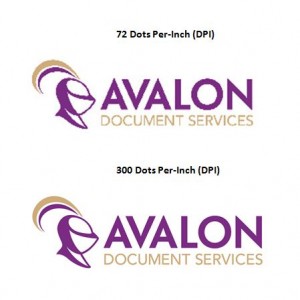It is all too common that people grab files from the web, want them blown up, printed out and expect to have a quality print. However, that will not be the case. Almost always the file’s resolution is too low to enlarge and the printed piece would look fairly blurry. But what does low resolution mean? What role does resolution play in print? Why is it important? How does it affect print quality?

Images that are used for the web will be low resolution, or LowRes. These images are about 72-95 dpi and will not look great when printed, especially if enlargement is desired. The dpi on files being used for digital or offset printing should be somewhere in the realm of 300 – 400 dpi. These HighRes files have more individual pixels per inch and will result in a sharper, cleaner, and crisper printed image.
As mentioned previously, resolution is sometimes referred to by the width and height of the image. Image size and resolution are directly related and you will need to know both when you are ready to print your image. Let’s say you have an image that is 1600 pixels x 1200 pixels. How big can you print this?
Honestly, you can print it as large as you want, but the quality will decrease as the size increases. Eventually as you enlarge the image more and more you will start to see that fuzzy, blurry look referred to as pixilation. In order to get a quality print of your image, here’s how to figure out the size you can print at.
You have a 1600×1200 image and want to print it at 300 dpi, which is recommended for digital or offset printing. How large can you print this image? Take 1600 and divide that by 300 which equals 5.33 and 1200 divided by 300 equals 4. Therefore if you print this 1600×1200 image at 300 dpi at a size of 5.33”x4”, the print will look great. However, anything larger than the 5.33”x4” will start to be pixilated and the quality will drop.
Let’s say instead you want to print an 8”x10” image at 300 dpi, which again is recommended for digital or offset printing. What should the file size be? Take 300 and multiple that by 8 which equals 2400. Then take 10 and multiple that by 300 which equals 3000. Therefore you would need a 2400×3000 size image to print a quality image at 8”x10”.
In addition to everything explained above, there are still a few tips and rules to follow and remember when dealing with any image for print.
- Resolution can be taken away but never added.
- The resolution needs to be set during the initial creation of that image. If you are scanning, shooting with a digital camera, or creating from scratch, the resolution you start with is the highest resolution you will get.
- If you enlarge an image, the resolution decreases and vice versa. Reduce an image size, and the resolution increases. For example: a 3 x 3″ image at 300 dpi enlarged to 6 x 6″ has a new resolution of 150 dpi.
- Photos should be at least 300dpi at final production size in the layout.
- Computer monitors generally have a display setting of 72 dpi which is much lower than the 300-400 dpi we expect for print production. If you are ever told some of your images are low resolution, they may not look bad on your monitor but will likely print blurry or jagged. Try zooming in on the image a few times. If you see that the image gets blurry or jagged after a few zooms, its low resolution.
- Web images are predominately low resolution at 72-96 dpi. This resolution is great for using over the internet, but not for printing. Printing these images will look bad, avoid using them in print whenever you can, or be prepared the quality will not be great.
Avalon can help with any of your print needs and can certainly help print your image at the best quality. If you ever want us to check your image’s resolution we can certainly let you know what it is, and also how large we can print your file. Just give us a call!
Reference: http://www.universalprinting.com/
If you liked this blog you might also be interested in reading: The Power of Vector Files
Learn how Avalon’s secure print and mail services allow you to focus on the bigger picture.


